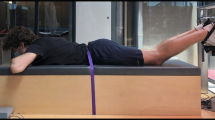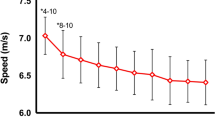Abstract
Electromechanical delay (EMD) of knee extensors in isometric contraction was investigated in six healthy men before and after four periods of 30-s all-out sprint cycling exercise, conducted pre and post a 7-week sprint cycling training programme. The EMD was lengthened from 40.4 (SEM 3.46) ms at rest to 63.4 (SEM 7.80) ms after the fatiguing exercise (P ≤ 0.05) in the pre-training test. During maximal voluntary contractions (MVC) conducted after the fatiguing exercise, the peak contraction force (F peak) and peak rate of force development (RFDpeak) were reduced by 51%–56% and 38%–50%, respectively (both P ≤ 0.05). The mechanisms of EMD lengthening during fatigue could have been due to the deterioration in muscle conductive, contractile or elastic properties and require further study. The training programme increased the total work performed during the four periods of sprint exercise (P ≤ 0.05). However, no significant training effects were found in the resting or postexercise EMD, F peak and RFDpeak during isometric MVC. These unchanged isometric contraction variables but enhanced dynamic performance suggest that isometric tests of muscle are insensitive to the neuromuscular adaptations to sprint training.
Similar content being viewed by others
References
Allen DG, Lee JA, Westerblad H (1989) Intracellular calcium and tension in isolated single muscle fibres from Xenopus. J Physiol (Lond) 415:433–458
Asmussen E, Bonde-Petersen F, Jørgensen K (1976) Mechano-elastic properties of human muscles at different temperatures. Acta Physiol Scand 96:83–93
Aura O, Komi PV (1987) Effects of muscle fibre distribution on the mechanical efficiency of human locomotion. Int J Sports Med [Suppl] 8:30–37
Bigland-Ritchie B, Donovan EF, Roussos CS (1981) Conduction velocity and EMG power spectrum changes in fatigue of sustained maximal effects. J Appl Physiol 51:1300–1305
Broman H, Bilotto G, De Luca CJ (1985) Myoelectric signal conduction velocity and spectral parameters: influence of force and time. J Appl Physiol 58:1428–1473
Cavanagh PR, Komi PV (1979) Electromechanical delay in human skeletal muscle under concentric and eccentric contractions. Eur J Appl Physiol 42:159–163
Gao Q, Qin YY, Wang RY, Xu JH, Zhou S, Bai XL, Zhao JQ, Hu Y, Han SZ, Xiong KY, Kang GW, Xian HZ, and Chen MY (1984) Medical and physiological observations on aged who practise Baguazhang. J Beijing Inst Phys Educ 4:39–45
Grabiner MD, Jaque V (1987) Activation patterns of the triceps brachii muscle during sub-maximal elbow extension. Med Sci Sports Exerc 19:616–620
Häkkinen K, Keskinen KL (1989) Muscle cross-sectional area and voluntary force production characteristics in elite strength- and endurance-trained athletes and sprinters. Eur J Appl Physiol 59:215–220
Hanson C, Lofthus G (1978) Effects of fatigue and laterality on fractionated reaction time. J Mot Behav 10:177–184
Horita T, Ishiko T (1987) Relationships between muscle lactate accumulation and surface EMG activities during isokinetic contractions in man. Eur J Appl Physiol 56:18–23
Jansson F, Esbjörnsson M, Holm I, Jacobs I (1990) Increase in the proportion of fast twitch muscle fibres by sprint training in males. Acta Physiol Scand 140:359–363
Juel C (1988) Muscle action potential propagation velocity changes during activity. Muscle Nerve 11:714–719
Kamen G, Kroll W, Clarkson PM, Zigon SL (1981) Fractional reaction time in power-trained and endurance-trained athletes under conditions of fatiguing isometric exercise. J Mot Behav 13:117–129
Kanehisa H, Miyashita M (1983) Effect of isometric and isotonic muscle training on static and dynamic power. Eur J Appl Physiol 50:365–371
Lynch GS, McKenna MJ, Williams DA (1994) Sprint-training effects on some contractile properties of single skinned human muscle fibres. Acta Physiol Scand 152:295–306
MacLaren DPM, Gibson H, Parry-Billings M, Edwards RHT (1989) A review of metabolic and physiological factors in fatigue. Exerc Sport Sci Rev 17:29–66
McKenna MJ (1992) The roles of ionic processes in muscular fatigue during intense exercise. Sports Med 13:134–145
McKenna MJ, Brittain M, Sale D, MacDougall JD, Heigenhauser GJF, McKelvie RS, Jones NL (1989) The effects of sprint training and fatigue upon the contractile properties of human skeletal muscle (abstract). Proc Aust Physiol Pharmacol Soc 20:55P
McKenna MJ, Schmidt TA, Hargreaves M, Cameron L, Skinner SL, Kjeldsen K (1993) Sprint training increases human skeletal muscle Na+-K+-ATPase concentration and improves K+ regulation. J Appl Physiol 75:173–180
McKenzie DK, Bigland-Ritchie B, Gorman RB, Gandevia SC (1992) Central and peripheral fatigue of human diaphragm and limb muscles assessed by twitch interpolation. J Physiol 454:643–656
Moritani T, Gaffney FD, Carmichael T, Hargis J (1985) Interrelationships among muscle fibre types, electromyogram, and blood pressure during fatiguing isometric contraction. In: Winter DA, Norman RW, Wells RP, Hayes KC, Patla AE (eds) Biomechanics IX-A. Human Kinetics, Champaign, Ill., pp 287–282
Nakajima S, Gilai A (1981) The use of merocyanine dyes as potential probes in skeletal muscle. In: Grinnell AD, Brazier MAB (eds) The regulation of muscle contraction: excitation-contraction coupling. Academic Press, London, pp 55–66
Nilsson J, Tesch P, Thorstensson A (1977) Fatigue and EMG of repeated fast voluntary contractions in man. Acta Physiol Scand 101:194–198
Parker RH (1985) The effects of mild one-legged isometric or dynamic training. Eur J Appl Physiol 54:262–268
Rüegg JC (1991) Calcium in muscle activation: a comparative approach. Springer, Berlin Heidelberg New York, pp 77
Saltin B, Gollnick P D (1983) Skeletal muscle adaptability: significance for metabolism and performance. In: Peachy LD, Adrian RH, Geiger SR (eds) Handbook of physiology, section 10. Williams and Wilkins, Baltimore, pp 555–631
Shorten MR (1987) Muscle elasticity and human performance. Med Sport Sci 25:1–18
Sjøgaard G, Adams RP, Saltin B (1985) Water and ion shifts in skeletal muscle of humans with intense dynamic knee extension. Am J Physiol 248:R190–196
Snow RJ, McKenna MJ, Carey MF, Hargreaves M (1992) Sprint training attenuated plasma ammonia accumulation following maximal exercise. Acta Physiol Scand 144:395–396
Stull GA, Kearney JT (1978) Effects of variable fatigue levels on reaction time components. J Mot Behav 10:223–231
Thorstensson A, Sjodin B, Karlsson J (1975) Enzyme activities and muscle strength after “sprint training” in man. Acta Physiol Scand 94:313–318
Vigreux B, Cnockaert JC, Pertuzon E (1980) Effects of fatigue on the series elastic component of human muscle. Eur J Appl Physiol 45:11–17
Viitasalo JT, Komi PV (1981) Interrelationships between electromyographical, muscle structure and reflex time measurements in man. Acta Physiol Scand 111:97–103
Vos EJ, Harlaar J, Van Ingen Schenau GJ (1991) Electromechanical delay during knee extensor contractions. Med Sci Sports Exerc 23:1187–1193
Vyskocil F, Hnik P, Rehfeldt H, Vejsada R, Ujec E (1983) The measurement of K+ concentration changes in human muscles during volitional contractions. Pflügers Arch 399:235–237
Westerblad H, Lee JA, Lännergren J, Allen DG (1991) Cellular mechanisms of fatigue in skeletal muscle. Am J Physiol 261:C195-C209
Zhou S (1995) Electromechanical delay in weight lifters and endurance trained athletes. In: Häkkinen K, Keskinen KL, Komi PV, Mero A (eds) Book of Abstracts, The XVth Congress of the ISB. Gummerus Kirjapaino OY, Jyväskylä, Finland, pp 1036–1037
Zhou S (1996) Acute effect of repeated maximal isometric contraction on electromechanical delay of knee extensor muscle. J Electromyogr Kinesiol (In press)
Zhou S, Lawson DL, Morrison WE, Fairweather I (1995a) Electromechanical delay in isometric muscle contractions evoked by voluntary, reflex and electrical stimulation. Eur J Appl Physiol 70:138–145
Zhou S, Lawson DL, Morrison WE, Fairweather I (1995b) Electromechanical delay of knee extensors: the normal range and the effects of age and gender. J Hum Mov Stud 28:127–146
Author information
Authors and Affiliations
Rights and permissions
About this article
Cite this article
Zhou, S., McKenna, M.J., Lawson, D.L. et al. Effects of fatigue and sprint training on electromechanical delay of knee extensor muscles. Eur J Appl Physiol 72, 410–416 (1996). https://doi.org/10.1007/BF00242269
Accepted:
Issue Date:
DOI: https://doi.org/10.1007/BF00242269




